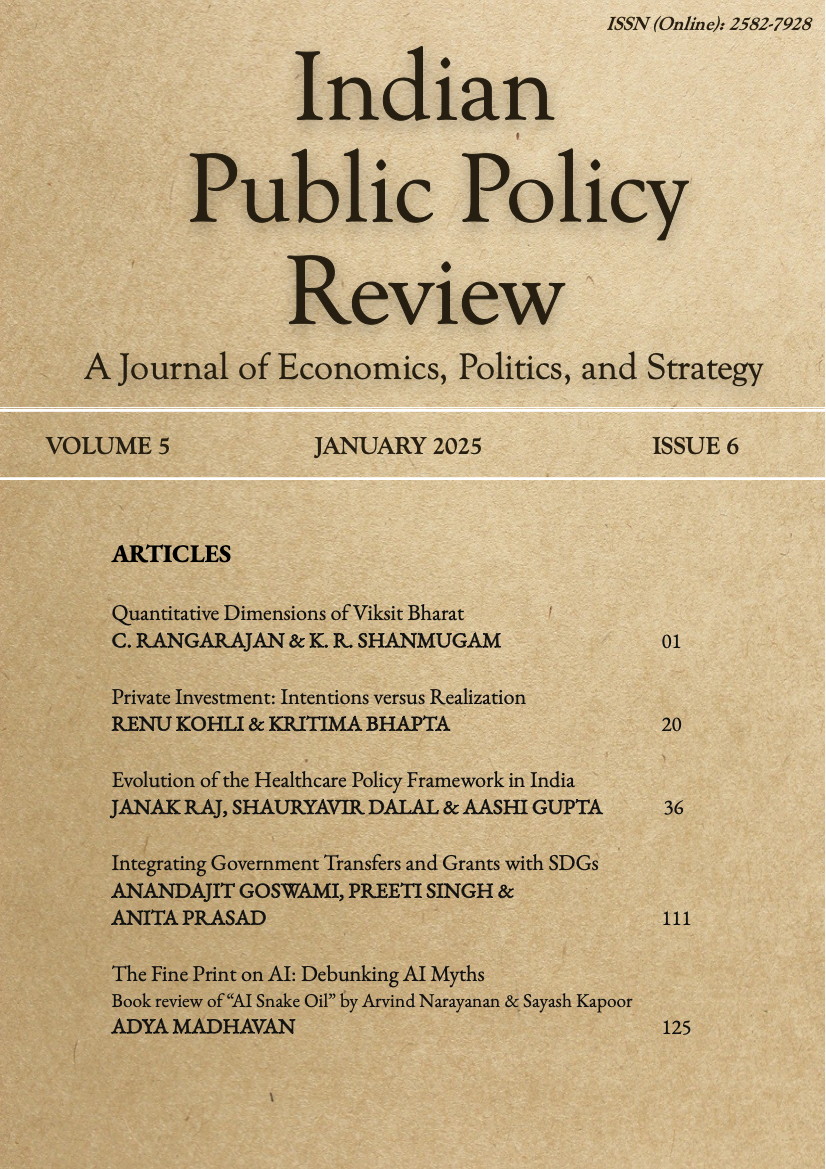Evolution of the Healthcare Policy Framework in India
DOI:
https://doi.org/10.55763/ippr.2025.05.06.003Abstract
This paper traces the history of the evolution of India's healthcare policy framework, focussing on its major objectives, challenges faced, and outcomes emerged. Though the groundwork for the healthcare framework was laid down by the Bhore Committee's well-thought-out report in 1946, it was only in 1983 that the country framed the first National Health Policy (NHP), followed by NHP -2002 and NHP-2017. Several other policy initiatives were also concurrently undertaken. The key themes prevalent across most of these policies and specific initiatives included: (i) increasing public health spending and reducing out-of-pocket or catastrophic health spending; (ii) addressing rural-urban inequalities in healthcare; (iii) developing primary healthcare; and (iv) achieving universal health coverage. Though the country has made a good progress in healthcare facilities post-independence, overall health has remained a low priority, with public health spending at one per cent of GDP - much lower than many of its peers. The rural-urban divide in healthcare services remains wide, with the relative neglect of primary healthcare. The goal of universal health coverage (UHC) is nowhere in sight mainly because of inadequate public health spending. UHC will require public health spending to rise to five per cent of GDP. Therefore, the central and state governments need to commit to raise public health spending to five per cent of GDP in a time-bound manner.
Keywords:
Healthcare Policy Framework, Universal Health Coverage, National Health Policy, Public Health Spending, Primary HealthcareDownloads
References
Annual Report 2019-20, Department of Health and Family Welfare, Ministry of Health and Family Welfare. https://main.mohfw.gov.in/sites/default/files/Annual%20Report%202019-2020%20English.pdf
Amrith, S. (2007). Political culture of health in India: A historical perspective. Economic and Political Weekly, 114-121.
Bagchi, A. (2010). Metamorphosis of Health Care: The transformation of “private” to “corporate” health care in post 1947 India. Proceedings of the Indian History Congress, 71, 1223–1232. http://www.jstor.org/stable/44147591
Carballido-Coria, L. (2022). The Bhore Committee (1943-1946): Health and colonialism, Darshika: Journal of Integrative and Innovative Humanities, 2(2), 49-67.
Demand for Grants 2022-23 Analysis: Health and Family Welfare.
Duggal, R. (1991). Bhore Committee (1946) and its relevance today. The Indian Journal of Paediatrics. 58. 395-406.
Duggal, R. (2001). Evolution of health policy in India. Centre for Enquiry into Health and Allied Themes.
Gangolli, L., Duggal, R., and Shukla, A. (2005). Review of Healthcare In India. Centre for Enquiry into Health and Allied Themes.
GOI, 1983. National Health Policy, 1983, Ministry of Health and Family Welfare.
GOI, 2017. National Health Policy, 2017, Ministry of Health and Family Welfare.
Government of India. (1946). Health Survey and Development Committee. Government of India Press. Calcutta (now Kolkata).
Indian Council of Medical Research, Public Health Foundation of India and Institute for Health Metrics and Evaluation. (2017). India: Health of the Nation’s States — The India State-Level Disease Burden Initiative. https://www.healthdata.org/sites/default/files/files/policy_report/2017/India_Health_of_the_Nation%27s_States_Report_2017.pdf
International Conference on Primary Health Care. (1978). Primary health care: report of the International Conference on Primary Health Care, Alma-Ata, USSR, 6-12 September 1978 / jointly sponsored by the World Health Organization and the United Nations Children's Fund. World Health Organization.
Joseph, J., Sankar, D. H., and Nambiar, D. (2021). Empanelment of health care facilities under Ayushman Bharat Pradhan Mantri Jan Arogya Yojana (AB PM-JAY) in India. PLoS One, 16(5), e0251814. https://doi.org/10.1371/journal.pone.0251814
Karan, A., Yip, W., and Mahal, A. (2017). Extending health insurance to the poor in India: An impact evaluation of Rashtriya Swasthya Bima Yojana on out-of-pocket spending for healthcare. Social Science & Medicine, 181, 83–92. https://doi.org/10.1016/j.socscimed.2017.03.053
Kumar A., Valecha, N., Jain, T., and Dash, A. P. (2007). Burden of malaria in India: retrospective and prospective view. American Journal of Tropical Medicine and Hygiene, 77(6 Suppl), 69-78.
Lahariya, C. (2014). A brief history of vaccines & vaccination in India. Indian Journal of Medical Research, 139(4), 491-511.
Mcintyre, D., Meheus, F., and Røttingen, J.-A. (2017). What level of domestic government health expenditure should we aspire to for universal health coverage? Health Economics, Policy and Law, 12(2), 125–137. https://doi.org/10.1017/S1744133116000414
Ministry of Health and Family Welfare. (2005). Report of the National Commission on Macroeconomics and Health.
Murthy, P., Sarin, A. and Jain, S. (2013). International Advisers to the Bhore Committee Perceptions and Visions for Healthcare. Economic and Political Weekly. XLVII. 71-76.
Mushtaq, M.U. (2009). Public health in British India: a brief account of the history of medical services and disease prevention in colonial India. Indian Journal of Community Medicine, 34(1), 6-14.
National Health Authority. (n. d.). About Pradhan Mantri Jan Arogya Yojana (PM-JAY). https://nha.gov.in/PM-JAY
National Health Systems Resource Centre (2022). National Health Accounts Estimates for India (2018-19). New Delhi: Ministry of Health and Family Welfare, Government of India.
Raj, Janak et al.(2023), ‘Economic Growth and Human Development in India; Inter-linkages’, (mimeo).
Raj, Janak (2023). Universal health coverage – The goal’s nowhere in sight. Hindustan Times, 22nd May, 2023.
Rao, Mohan. (2004). From population control to reproductive health: Malthusian arithmetic. New Delhi: Sage Publications.
Report No. 10, Performance Audit on Pradhan Mantri Swasthya Suraksha Yojana, August 7, 2018, https://cag.gov.in/content/reportno10-2018-performance-audit-pradhan-mantri-swasthya-suraksha-yojana-ministry-health.
Sapru, R. K. (1997). Health Care Policy and Administration in India. Indian Journal of Public Administration, 43(3), 731–748. https://doi.org/10.1177/0019556119970340
Sapru, R. K. (2021). Health Policy and National Health Mission (Lecture Notes). https://www.egyankosh.ac.in/bitstream/123456789/76672/1/Unit-11.pdf
Sharma, P. (2023, Jan 21). Govt to combine CGHS with Ayushman Bharat. Livemint. https://www.livemint.com/economy/govt-to-combine-cghs-with-ayushman-bharat-11674230060192.html
Sharma, V. P. (1996). Re-emergence of malaria in India. Indian Journal of Medical Research, 103, 26-45.
Sokhey, J., Kim-Farley, R. J., and Bhargava, I. (1989). The expanded programme on immunization: A decade of progress in India. Annals of Tropical Paediatrics, 9(1), 24–29. https://doi.org/10.1080/02724936.1989.11748590
Thakur, J. S. (2011). Key recommendations of high-level expert group report on universal health coverage for India. Indian Journal of Community Medicine: Official Publication of Indian Association of Preventive & Social Medicine, 36(Suppl1), S84.
World Health Organization (WHO). (1978). International Conference on Primary Health Care. Jointly Sponsored by WHO and United Nations Children’ Fund, September 6-12. Geneva.
World Health Organization (WHO). (2009). Health Financing Strategy for the Asia Pacific Region (2010-2015). WHO Regional Office for the Western Pacific. https://apps.who.int/iris/handle/10665/207746


